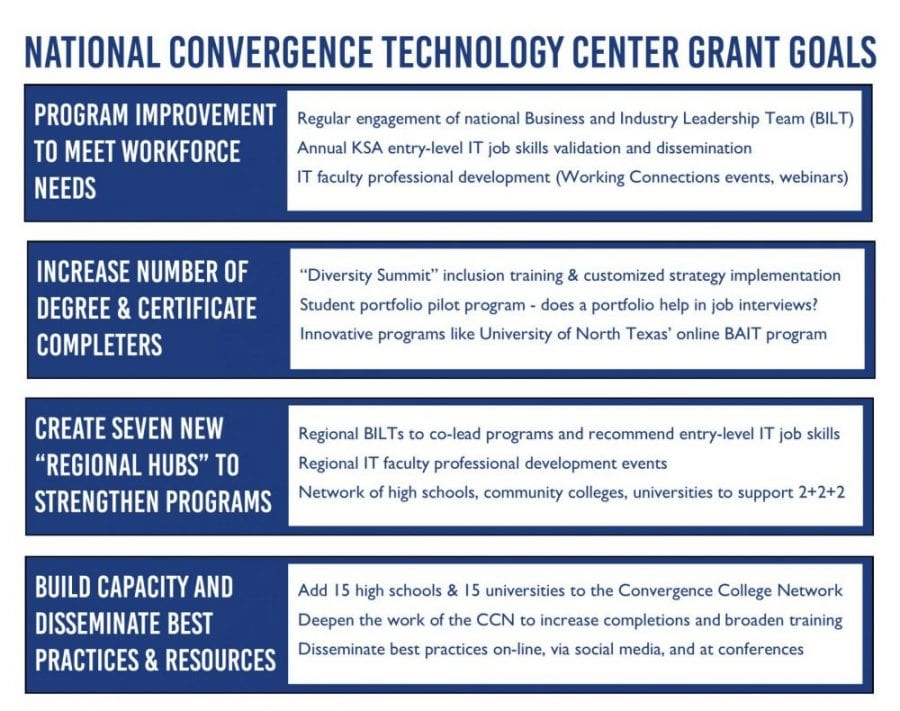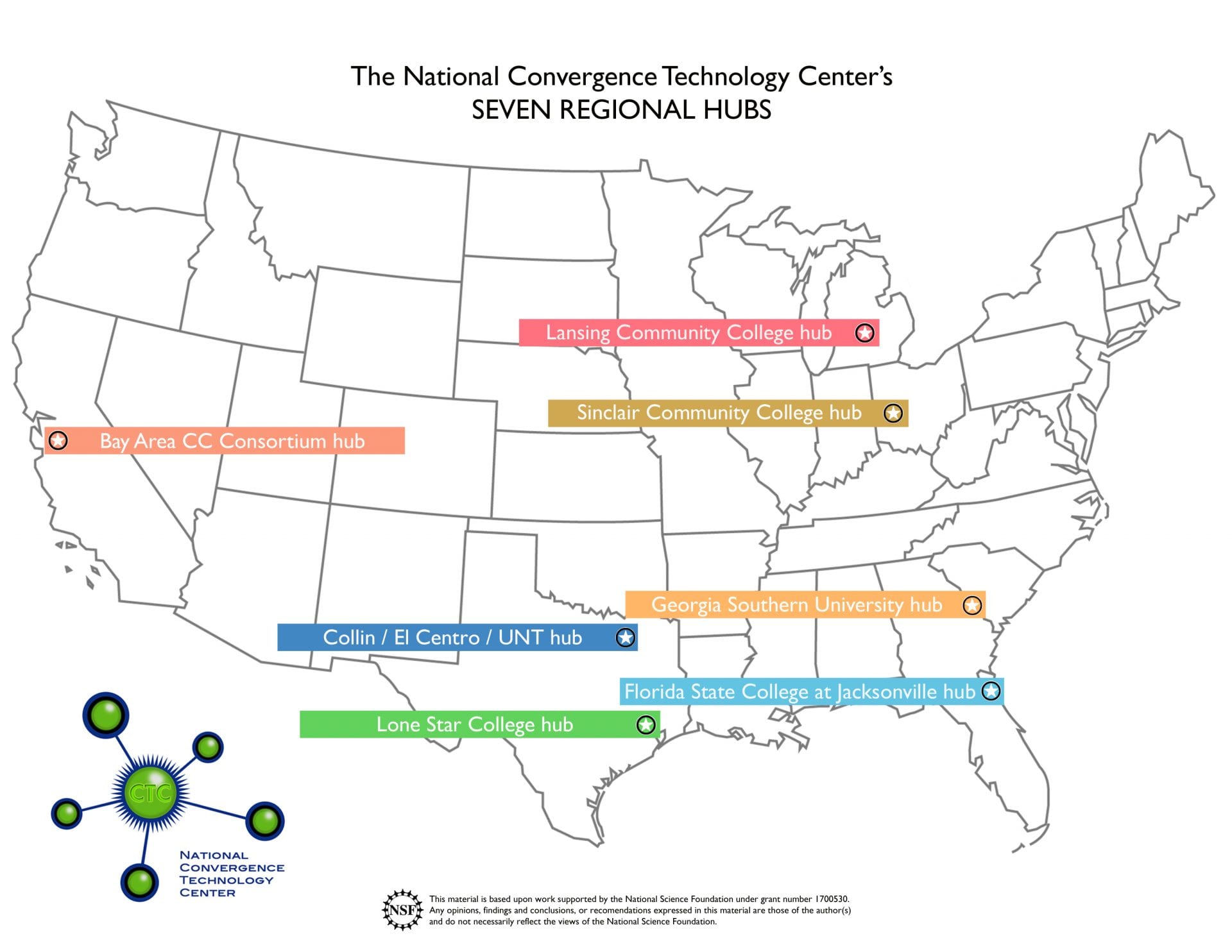The National Convergence Technology Center was established to meet the workforce need for skilled specialists in Convergence Technology, Information Technology, and Cybersecurity.
The CTC pulls together the strengths of both educators and business professionals to create a pool of qualified IT technicians to design, build, test, secure, and troubleshoot communication infrastructure and devices in the convergence technology arena, both for enterprise and home markets. This means serving as a nationwide bridge between business and industry that understand the essential skills IT workers need, educators that must design and implement the curriculum to teach those skills, and students that benefit from this close collaboration between business and education by graduating with "workforce ready" know-how that will get them hired.
The National Convergence Technology Center is funded by the National Science Foundation. As an ATE National Center of Excellence, the CTC is committed to helping support students in learning the cutting-edge skills they need to get and keep a high-wage career with expansive future potential in IT.
Goals

One of the goals of the National CTC is the creation of seven regional hubs. Please see the map below. In 2022, the National CTC's grant funding - which began in 2012 with the first national center grant - will end and the center will "sunset." The National Science Foundation's ATE program is purposely designed this way to give other educators and grantees a chance to participate. The purpose of the regional hubs is to develop communities that can continue the National CTC's work after it's gone. These hubs will establish engaged, regional Business and Industry Leadership Teams (BILTs) to give feedback on local workforce needs; create robust networks of educators from high schools, community colleges, and four-year universities modeled on the National CTC's Convergence College Network (CCN) community that shares resources and know-how; use that network to create new 2+2+2 articulation pathways for IT students in the region; collectively apply for NSF ATE project grants; and host faculty training events on-line or in person that feature longitudinal surveying to measure true impact.
As of 2018, Lone Star College is the first grant partner to begin the process of establishing a regional hub. The other hubs will soon follow.

1. Program improvement to meet workforce needs
- Established the National Business and Industry Leadership Team (BILT), a group of IT industry thought leaders, who forecast market needs and provide industry trends on a national level to assist Convergence College Network (CCN) colleges. The BILT's mission is to make sure program curriculum aligns with workforce needs so students learn the skills that get them hired. Since 2014, over 35 different companies and organizations have been a part of the BILT.
- Continued to co-sponsor the regional "Cloud and Emerging Convergence Summit" conference that exposes a diverse audience of educators to the work of the National CTC. One of the conference's concurrent tracks is programmed by the National CTC, allowing representatives from its mentored colleges to offer best-practices presentations.
- Update curriculum every year by asking the BILT to analyze current knowledge, skills, and abilities lists for convergence classes, insuring the content remains relevant and up-to-date.
- Hosts professional training events called "Working Connections IT Faculty Development Institute." These annual events (three days online in December, five days in-person in July) allow IT educators from around the country to learn in-depth a specific emerging IT or pedagogy topic they can then teach at their home school. Working Connections has reached over 1683 duplicated enrollments (740+ educators) since 2002. In the last five years alone, Working Connections training has directly led to the creation of over 200 new degrees, certificates, specializations, or courses and impacted over 52,200 students.
- Delivered three "best practice" tracks at Summer Working Connections to teach organizational and pedagogical processes and strategies to help strengthen IT programs and improve the classroom experience. Attendees of these tracks develop a customized action plan of strategies they want to implement at their home program. As of 2018, attendees from the 2016 and 2017 tracks had already completed or partially completed 54% of their goals.
- Assisted the expansion of the five-day summer Working Connections event to other regions - South (Florida – 2013-2018) and North (Michigan – 2013, 2017; Wisconsin – 2014) – reaching 250 duplicated enrollments.
- Tracks the true impact of the Working Connections events with comprehensive longitudinal "effectiveness" surveys sent each January to the previous five Working Connections cohorts. These surveys measure the true classroom impact of Working Connections training. The most recent survey collected 418 responses. Seventy-four percent of respondents selected a Working Connections track topic that they were not already teaching, meaning that they are introducing new skills to their students. When asked if they are still teaching the topic they learned at Working Connections, almost half of the respondents answered "yes" – including 53% of attendees from the 2013 events – showing the lasting impact of the training.
- Provided additional virtual labs that allow students to complete labs anytime, anyplace 24-7 so long as they have internet access. Since 2016, over 3500 students from CCN member schools have been able to take advantage of this service.
- Implemented a pilot virtual internship/externship model that gave students the opportunity to create a group project response to an enterprise RFP with industry mentorship. Students presented their solution to a "jury" of industry executives and simulate a real-world business environment.
Going forward, the National CTC will convene special BILTs to explore the intersection of IT and other technologies – such as manufacturing or biotechnology – to develop a list of entry-level knowledge, skills, and abilities for those emerging jobs.
2. Increase the number of degree/certificate completers ready to meet workforce needs
- Developed more "stackable certificates," smaller collections of classes that allow schools to align certificates to degrees, to better quantify "completers," and to provide students the skills that are most in-demand. These smaller certificates "stack" to a degree.
- Continues transferring students to the BA in Information Technology (BAIT) at the University of North Texas, which accepts up to 21 hours of workforce class credit. Enrollment has increased from 42 in its inaugural semester in Fall 2008 to 164 students in Fall 2017. The program is ABET accredited through 2021. To further broaden the reach, UNT is a transition of the BAIT degree to an online format and a network of "mentored universities" to more seamlessly transfer two-year convergence students to its four-year program.
- Created the "Diversity Summit" pilot that trained faculty, administrators, and counselors from nine institutions on best practices for recruiting and retaining under-served populations, then provided support for those nine teams to implement a customized diversity strategy. The plans were designed to measure enrollment data so that the teams could persuade their administrators to "institutionalize" the successful strategies long-term. As of early 2018, two teams met or exceeded their goals with reports from the other teams pending final analysis.
During the renewal grant period, the National CTC will develop – as directed by its national BILT and investigated by faculty from the CTC's grant partner schools – student portfolio methodology to determine how IT portfolios that concretely and clearly demonstrate student know-how might help graduates get hired more quickly than those without similar portfolios.
3. Create new regional hubs to increase prepared faculty and employable IT graduates
As mentioned above, going forward the National CTC will develop seven regional "hubs." The purpose of the regional hubs is to develop communities that can continue the National CTC's work after it's gone. These hubs will establish engaged, regional Business and Industry Leadership Teams (BILTs) to give feedback on local workforce needs; create robust networks of educators from high schools, community colleges, and four-year universities modeled on the National CTC's Convergence College Network (CCN) community that shares resources and know-how; use that network to create new 2+2+2 articulation pathways for IT students in the region; collectively apply for NSF ATE project grants; and host faculty training events on-line or in person that feature longitudinal surveying to measure true impact.
Lone Star College in Houston has started the process of establishing a regional hub.
4. Capacity Building to expand the CCN
- Mentors over 60 colleges from 24 states around the country in a "community of practice" – called the Convergence College Network (CCN) – that collaboratively evaluates and updates their individual programs, creates their BILT business teams, modifies/creates degree and certificate programs, and recruits students. This group meets quarterly (three times on the phone and once in person) to deliver updates on their programs' progress; make presentations on recent challenges and successes; and share resources and best practices.
- Started two new "community of practice" CCN subgroups – one for administrators, one for four-year university faculty members – that provide a separate, bi-annual forum to discuss challenges unique to those groups.
- Hosts regular professional development webinars on a variety of technical and pedagogical topics (STEM summer camps; micro-messaging and unconscious bias; transformations in the IT workplace; using PC repair clinics to teach soft skills; CAE2Y certification; competency-based education programs). During the renewal period, the National CTC will focus on using these kinds of webinars to broaden and deepen the training of the CCN on best practices and resources.
- Promotes services and resources, including strategies to develop a successful BILT, through presentations and exhibition booths at the League for Innovation conference, High Impact Technology Exchange (HI TEC) conference, STEMtech, WASTC Winter ICT Educators' conference, and the National Career Pathways Network (NCPN) conference, as well as the ATE Principal Investigators' conference. Since 2015, CTC and CTC partner conference presentations have reached over 1480 attendees through almost 70 individual breakout sessions, roundtables, and workshops. Twenty-one of those (30%) were focused on the BILT model and boosting student employability skills.
- Developed a robust set of digital platforms to disseminate program information, promote events, and increase the National CTC's overall outreach. In addition to a traditional website, the National CTC regularly updates a Facebook page (6000+ page reach in 2017), a Twitter account (44,800+ impressions in 2017), a YouTube channel (21 new clips added in 2017), and a LinkedIn group page for the national BILT. The National CTC also pushes content out through a weekly blog and a monthly newsletter (1980+ subscribers in 2017). Wikispaces is also an important sharing tool for events and best practices documents. The National CTC also regularly archives key documents, tools, and presentations with ATE Central.
- Participates in a special Centers Collaborative for Technical Assistance (CCTA) group that delivered best practice training from several NSF ATE centers. Since January 2015, CCTA has hosted 40 webinars reaching 2834 unduplicated attendees and hosted 4 special in-person convenings reaching 258 people. CCTA has also created and posted online 12 best practice documents for use as references.
During the renewal grant period, the National CTC will expand the CCN membership by adding 15 high schools and 15 four-year universities around the seven regional hubs.
